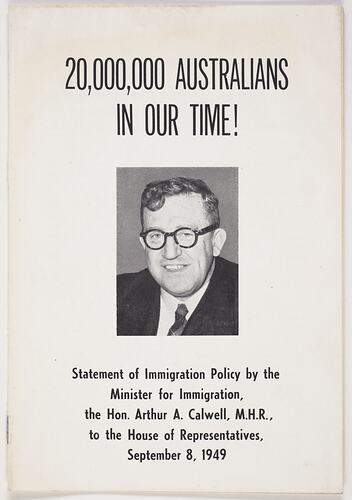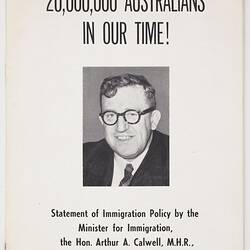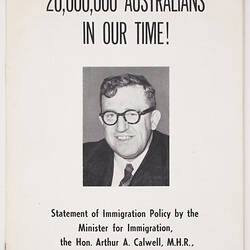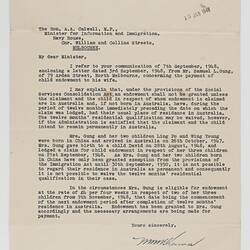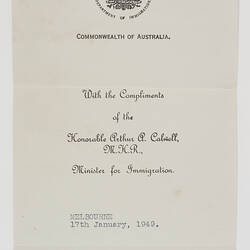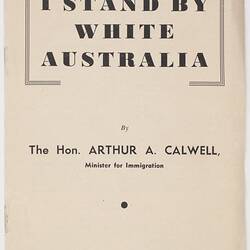Summary
Black and white printed pamphlet titled '20,000,000 Australians In Our Time!' written by Arthur Calwell on 8 September 1949. The pamphlet contains a statement given by the Minister for Immigration, the Hon. Arthur A. Calwell, M.H.R. to the House of Representatives on 8 September, 1949. The statement outlines the statistics, policy and mechanisms of post World War II migration from Europe which Calwell undertook as Australia's first Minister for Immigration. It also provides details about the Australian Citizenship Act which had just been introduced in 1949 and the economic growth stimulated by the immigration drive as well as the way immigrants were settling into the country.
Under the catch cry of 'populate or perish!' Calwell sought to expand Australia's traditional immigration base from the British Isles to Eastern and Southern Europe. The following quote from this pamphlet illustrates some of his arguments: 'there can be no argument against immigration at this point of Australian history. We must fill this country or we will lose it. But even if there were no urgent security reason for our immigration drive, there would be sound and cogent economic ones.'
Physical Description
Black and white printed pamphlet of 6 pages bound with two staples in the centre. In the centre of the front cover is a black and white photograph of Arthur Calwell.
Significance
The significance of this document lies in the statement of policy of post World War II immigration by Australia's first Minister of Immigration, Arthur Calwell. The pamphlet outlines the policy, statistics and mechanisms of migration from 1945 to 1949 under Calwell's direction. It was a policy that was to change the ethnic and religious make up of Australia as well as to be the main driver of population and economic growth after World War II and its effects can still be seen today. It is also important as an early document outlining the policies and programs surrounding the introduction of the British Nationality and Australian Citizenship Act earlier in 1949.
The pamphlet also contains Calwell's view about the settlement of immigrants and the importance of citizenship. He notes some challenges faced by migrants and the Australian population: 'We need to absorb immigrants into suitable employment; we must house and accommodate them; we must accept them as new Australians who will, sooner or later, share all the benefits and accept all the obligations of our common citizenship.' He goes on to say that: 'The problems of the immigrants are the problems of the nation; solving those problems is the duty of us all.' Calwell uses this speech to reannounce the Australian Citizenship Convention to be held in Canberra from January 23rd to 27 1950 as part of the celebrations of the first anniversary of the proclamation of the British Nationality and Australian Citizenship Act. He emphasises that the convention is not only concerned with European migrants but also British migrants who also need support in settling in Australia and mentions various programs, such as the Good Neighbour Movement, various churches and the various reception and training centres around Australia used to accommodate and settle new migrants.
Arthur Calwell entered federal politics in 1940 by winning the seat of Melbourne and gained the portfolio of Information in Curtain's second term of government in 1943. Calwell became Australia's first immigration minister in 1945 and during his time as minister he expanded Australia's traditional immigration based to include eastern and Southern Europe as well as the United Kingdom. His catchphrase of 'populate or perish' was used to encourage the general population to accept the large humbers of migrants after World War II and was his argument for the preservation of a White Australia. The pamphlet contains statistics about the migrants arriving in Australia 'I am confident that in the twelve months ending on June 30th, 1950, at least 170,000 newcomers will arrive in Australia' and states his aim of Australia's population being 20,000,00 people in his generation's lifetime. He notes that regional developoment will be a part of future population policy.
More Information
-
Collecting Areas
-
Acquisition Information
Purchase
-
Author
Mr Arthur Calwell, Canberra, Australian Capital Territory, Australia, 8 Sep 1949
-
Inscriptions
Title: '20,000,000 Australians In Our Time!'. Below the photograph on the front cover is 'Statement of Immigration Policy by the Minister for Immigration, the Hon. Arthur A. Calwell, M.H.R., to the House of Representatives, September 8, 1949.'
-
Classification
-
Category
-
Discipline
-
Type of item
-
Overall Dimensions - Closed
239 mm (Width), 202 mm (Height)
-
References
[Link 1] A. A. Calwell, "20,000,000 Australians In Our Time!" September 8, 1949.
-
Keywords
Citizenship, Good Neighbour Movement, Immigration Policies, Immigration Selection, Migration Schemes, Population
